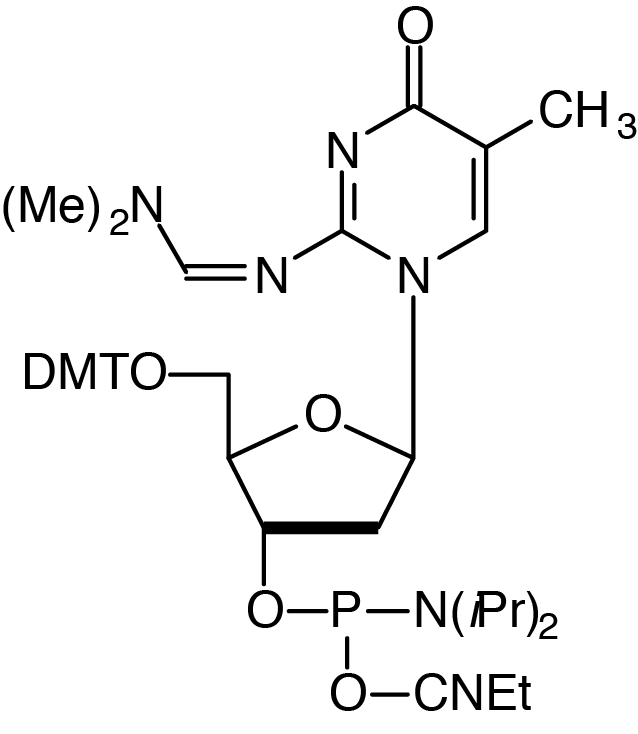| dmf-5-Me-isodC-CE Phosphoramidite |

Catalog Number: 10-1065-xx
Description: dmf-5-Me-isodC-CE Phosphoramidite
5'-Dimethoxytrityl-5-methyl-N-dimethylformamidine-2'-deoxyisoCytidine,
3'-[(2-cyanoethyl)-(N,N-diisopropyl)]-phosphoramidite |
| Formula: C43H55N6O7P |
M.W.: 798.91 |
F.W.: 303.21 |
Diluent: Anhydrous Acetonitrile |
| Coupling: No changes needed from standard method recommended by synthesizer manufacturer. Mild Deblocking Mix Required. Use 2.5-3% DCA instead of TCA |
| Deprotection: No changes needed from standard method recommended by synthesizer manufacturer.Note: Oligos containing 5-Me-iso-dC should be stored buffered at pH 7.5 to 8.0 to avoid decomposition. |
| Storage: Refrigerated storage, maximum of 2-8°C, dry |
| Stability in Solution: 2-3 days |
| Please Note: These products are supplied under license from EraGen Biosciences, Inc. US Patents 5,432,272, 6,001,983, 6,037,120, and 6,140,496. |
Unnatural base pairs display unique abilities in duplex DNA and in nucleic acid and protein biosyntheses. A standard Watson and Crick base pair is formed between iso-C and iso-G, but the hydrogen bonding pattern is quite different from the natural base pairs A-T and C-G. (The 5-methyl analogue was chosen as the synthetic target due to the reported instability of 2’-deoxyisocytidine caused by deamination during oligonucleotide synthesis or deprotection.)
The unnatural base pair between 7-(2-thienyl)-imidazo[4,5-b]pyridine (Ds) and pyrrole-2-carbaldehyde (Pa) is formed by specific hydrophobic shape complementation. The shape of the Ds-Pa pair is different from those of the natural A-T and G-C pairs, but the Ds-Pa pair works together with the natural pairs in in vitro replication and transcription. Pa also functions as a template base for incorporating another unnatural base, 2-amino-6-(2-thienyl)purine (s), into RNA. The s base also acts as a unique fluorescent base analog in DNA and RNA fragments. dDss is strongly fluorescent and is useful as a fluorescent tag for DNA detection. dDss also forms a base pair with dPa. Biotin PaTP can be site-specifically incorporated into RNA, opposite dDs at a desired position in DNA templates, by T7 transcription. Similarly, the fluorescent s base can be site-specifically incorporated into RNA opposite dPa in DNA templates.
If you cannot find the answer to your problem then please contact us or telephone +44 (0)1954 210 200